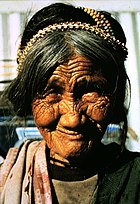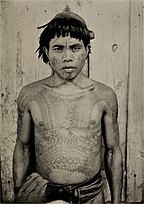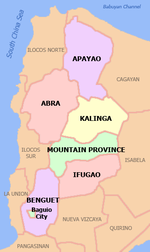Bontoc, Mountain Province
 From Wikipedia - Reading time: 13 min
From Wikipedia - Reading time: 13 min
Bontoc | |
|---|---|
| Municipality of Bontoc | |
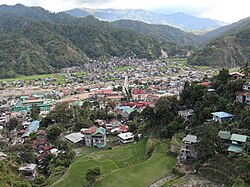 Bontoc in 2022 | |
 Map of Mountain Province with Bontoc highlighted | |
Location within the Philippines | |
| Coordinates: 17°05′24″N 120°58′38″E / 17.09°N 120.9772°E | |
| Country | Philippines |
| Region | Cordillera Administrative Region |
| Province | Mountain Province |
| District | Lone district |
| Founded | 1908 |
| Barangays | 16 (see Barangays) |
| Government | |
| • Type | Sangguniang Bayan |
| • Mayor | Jerome B. Tudlong, Jr. |
| • Vice Mayor | Eusebio S. Kabluyen |
| • Representative | Maximo Y. Dalog Jr. |
| • Municipal Council | Members |
| • Electorate | 17,135 voters (2022) |
| Area | |
• Total | 396.10 km2 (152.94 sq mi) |
| Elevation | 1,173 m (3,848 ft) |
| Highest elevation | 1,833 m (6,014 ft) |
| Lowest elevation | 804 m (2,638 ft) |
| Population (2020 census)[4] | |
• Total | 24,104 |
| • Density | 61/km2 (160/sq mi) |
| • Households | 6,452 |
| Economy | |
| • Income class | 2nd municipal income class |
| • Poverty incidence | 4.49 |
| • Revenue | ₱ 193.7 million (2020), 73 million (2012), 87.69 million (2013), 101 million (2014), 114 million (2015), 124.9 million (2016), 138.9 million (2017), 203.3 million (2018), 160.6 million (2019), 259 million (2021), 192.7 million (2022) |
| • Assets | ₱ 380.3 million (2020), 111.7 million (2012), 102.6 million (2013), 118.7 million (2014), 175 million (2015), 279.8 million (2016), 264.1 million (2017), 344.2 million (2018), 376.6 million (2019), 362.4 million (2021), 402.1 million (2022) |
| • Expenditure | ₱ 147.8 million (2020), 63.98 million (2012), 71.91 million (2013), 79.78 million (2014), 87.56 million (2015), 96.1 million (2016), 108.6 million (2017), 177 million (2018), 134.3 million (2019), 159.6 million (2021), 194.9 million (2022) |
| • Liabilities | ₱ 159.8 million (2020), 34.15 million (2012), 21.69 million (2013), 30.51 million (2014), 87.5 million (2015), 107.2 million (2016), 137.3 million (2017), 177.4 million (2018), 186 million (2019), 116.2 million (2021), 119.2 million (2022) |
| Service provider | |
| • Electricity | Mountain Province Electric Cooperative (MOPRECO) |
| Time zone | UTC+8 (PST) |
| ZIP code | 2616 |
| PSGC | |
| IDD : area code | +63 (0)74 |
| Native languages | Balangao Bontoc Ilocano Tagalog |
| Website | lgubontoc |
Bontoc, officially the Municipality of Bontoc (Ilocano: Ili ti Bontoc; Tagalog: Bayan ng Bontoc), is a 2nd class municipality and capital of the province of Mountain Province, Philippines. According to the 2020 census, it has a population of 24,104 people.[4]
Bontoc is 392 kilometres (244 mi) from Manila, 20 kilometres (12 mi) from Sagada, and 142 kilometres (88 mi) from Baguio.
Bontoc is the historical capital of the entire Cordillera region since the inception of governance in the Cordillera. The municipality celebrates the annual Lang-ay Festival.[6]
Bontoc is home to the Indigenous Bontoc people. The town also hosts the UNESCO tentatively-listed Alab petroglyphs.
History
[edit]This section needs expansion. You can help by adding to it. (December 2015) |

Samuel E. Kane, the American supervisor and then Governor, established the capital here after the Philippine Commission passed the Mountain Province Act in 1908,[7] building a provincial building, hospital, doctor's office, nurse's home, a school, and provincial prison.[8]: 281–284 He also built the Tagudin-Bontoc trail, which by 1926, could accommodate a small car.[8]: 329
Bontoc was one of several municipalities in Mountain Province which would have been flooded by the Chico River Dam Project during the Marcos, alongside Bauko, Sabangan, Sagada, Sadanga, and parts of Barlig.[9] However, the indigenous peoples of Kalinga Province and Mountain Province resisted the project and when hostilities resulted in the murder of Macli-ing Dulag, the project became unpopular and was abandoned before Marcos was ousted by the 1986 People Power Revolution.[10]
Geography
[edit]Barangays
[edit]Bontoc is politically subdivided into 16 barangays. Each barangay consists of puroks and some have sitios.
- Alab Oriente
- Alab Proper
- Balili
- Bayyo
- Bontoc Ili
- Calutit
- Caneo
- Dalican
- Gonogon
- Guinaang
- Mainit
- Maligcong
- Poblacion (Bontoc)
- Samoki
- Talubin
- Tocucan
Climate
[edit]| Climate data for Bontoc, Mountain Province | |||||||||||||
|---|---|---|---|---|---|---|---|---|---|---|---|---|---|
| Month | Jan | Feb | Mar | Apr | May | Jun | Jul | Aug | Sep | Oct | Nov | Dec | Year |
| Mean daily maximum °C (°F) | 23 (73) |
24 (75) |
25 (77) |
27 (81) |
27 (81) |
26 (79) |
25 (77) |
25 (77) |
25 (77) |
25 (77) |
24 (75) |
23 (73) |
25 (77) |
| Mean daily minimum °C (°F) | 16 (61) |
16 (61) |
17 (63) |
19 (66) |
20 (68) |
21 (70) |
21 (70) |
21 (70) |
20 (68) |
19 (66) |
18 (64) |
17 (63) |
19 (66) |
| Average precipitation mm (inches) | 35 (1.4) |
46 (1.8) |
63 (2.5) |
117 (4.6) |
402 (15.8) |
400 (15.7) |
441 (17.4) |
471 (18.5) |
440 (17.3) |
258 (10.2) |
94 (3.7) |
68 (2.7) |
2,835 (111.6) |
| Average rainy days | 9.9 | 9.5 | 13.9 | 18.9 | 26.0 | 27.3 | 28.9 | 28.5 | 26.1 | 19.7 | 14.5 | 12.8 | 236 |
| Source: Meteoblue (modeled/calculated data, not measured locally)[11] | |||||||||||||
Demographics
[edit]
|
|
| |||||||||||||||||||||||||||||||||||||||||||||||||||
| Source: Philippine Statistics Authority[12][13][14][15] | |||||||||||||||||||||||||||||||||||||||||||||||||||||
Most inhabitants speak the Bontoc language, with other major languages being Kankana-ey and Ilocano. Minor languages spoken include Tagalog, Pangasinan, Cuyonon and Butuanon.[16]
Economy
[edit]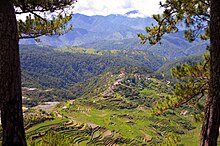
Poverty incidence of Bontoc
5
10
15
20
2006
15.10 2009
16.71 2012
10.86 2015
15.43 2018
10.01 2021
4.49 Source: Philippine Statistics Authority[17][18][19][20][21][22][23][24] |
The local economy depends largely on small trades and agriculture. This capital town's biggest economic potential is tourism with its smaller rice terraces in Barangay Bay-yo, Maligcong and other areas.[25]
Government
[edit]Local government
[edit]Bontoc, belonging to the lone congressional district of the province of Mountain Province, is governed by a mayor designated as its local chief executive and by a municipal council as its legislative body in accordance with the Local Government Code. The mayor, vice mayor, and the councilors are elected directly by the people through an election which is being held every three years.
Elected officials
[edit]Members of the Municipal Council (2019–2022):[26]
- Congressman: Maximo Y. Dalog Jr.
- Mayor: Jerome “Chagsen” Tudlong, Jr.
- Vice-Mayor: Eusebio S. Kabluyen
- Councilors:
- Jupiter Kalangeg
- Dan Evert Sokoken
- Timothy Pongad
- Glenn Bacala
- Peter C. Kedawen
- Julian Chumacog
- Benedict Odsey II
- Viola Okko
Culture
[edit]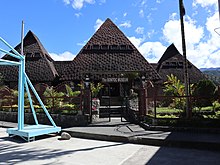
The highland town of Bontoc is home to two National Cultural Treasures of the Philippines. These are the Stone Agricultural Calendar of Bontoc and Petroglyphs of Alab.[27]
The Alab petroglyphs are ancient figures carved on mountain walls by the prehistoric people of Bontoc.[28] The petroglyphs are the most important ancient rock art carvings in the Cordilleras and the second oldest in the entire country, second only to the Angono petroglyphs of Rizal. Due to its high significance, it was submitted by the National Commission for Culture and the Arts of the Philippines to the UNESCO Tentative List of Heritage Sites in 2006, pending its inclusion in the World Heritage List along with the Singanapan charcoal-drawn petrographs of southern Palawan, Angono petroglyphs of Rizal province, charcoal-drawn Peñablanca petrographs of Cagayan, and the Anda red hermatite print petrographs of Bohol.
Education
[edit]Secondary education
[edit]- ALBAGO National High School, Balili
- Dalican National High School, Dalican
- Guina-ang National High School, Guina-ang
- Mountain Province General Comprehensive High School, Poblacion
- Saint Vincent School, Poblacion
- Talubin National High School, Talubin
- Tocucan National High School, Tocucan
Tertiary education
[edit]Mountain Province State University is the first tertiary institution in the municipality that offers various undergraduate and graduate courses.
XiJen College of Mountain Province is the only private tertiary institution that also offers technical-vocational courses.
Notable People
[edit]- Lamberto V. Avellana - National Artist of the Philippines for Film
- Francisco Claver, SJ - Roman Catholic bishop, Jesuit, and human rights activist
References
[edit]- ^ "2019 Election Results:Bontoc, Mountain Province". GMA News. Retrieved October 7, 2021.
- ^ Municipality of Bontoc | (DILG)
- ^ "2015 Census of Population, Report No. 3 – Population, Land Area, and Population Density" (PDF). Philippine Statistics Authority. Quezon City, Philippines. August 2016. ISSN 0117-1453. Archived (PDF) from the original on May 25, 2021. Retrieved July 16, 2021.
- ^ a b Census of Population (2020). "Cordillera Administrative Region (CAR)". Total Population by Province, City, Municipality and Barangay. Philippine Statistics Authority. Retrieved July 8, 2021.
- ^ "PSA Releases the 2021 City and Municipal Level Poverty Estimates". Philippine Statistics Authority. April 2, 2024. Retrieved April 28, 2024.
- ^ Malingan, Jamie Joie (April 12, 2018). "Feature: Lang-Ay Festival: Celebrating a Culture of Sharing". Philippine Information Agency. Archived from the original on February 22, 2019. Retrieved February 22, 2019.
- ^ "Act No. 1876". PhilippineLaw.info. August 18, 1908. Archived from the original on October 15, 2014. Retrieved October 22, 2014.
- ^ a b Kane, S.E., 1933, Thirty Years with the Philippine Head-Hunters, New York: Grosset & Dunlap
- ^ "Valley of Sorrow". Asiaweek. September 5, 1980.
- ^ Doyo, Ma. Ceres P. (2015). Macli-ing Dulag: Kalinga Chief, Defender of the Cordillera. Diliman, Quezon City: University of the Philippines Press. ISBN 978971542772-2.
- ^ "Bontoc: Average Temperatures and Rainfall". Meteoblue. Retrieved March 8, 2020.
- ^ Census of Population (2015). "Cordillera Administrative Region (CAR)". Total Population by Province, City, Municipality and Barangay. Philippine Statistics Authority. Retrieved June 20, 2016.
- ^ Census of Population and Housing (2010). "Cordillera Administrative Region (CAR)" (PDF). Total Population by Province, City, Municipality and Barangay. National Statistics Office. Retrieved June 29, 2016.
- ^ Censuses of Population (1903–2007). "Cordillera Administrative Region (CAR)". Table 1. Population Enumerated in Various Censuses by Province/Highly Urbanized City: 1903 to 2007. National Statistics Office.
- ^ "Province of Mountain Province". Municipality Population Data. Local Water Utilities Administration Research Division. Retrieved December 17, 2016.
- ^ "Annual Report; Local Government of Bontoc; CY 2011" (PDF). Local Government of Bontoc. 2011. Retrieved February 22, 2019.
- ^ "Poverty incidence (PI):". Philippine Statistics Authority. Retrieved December 28, 2020.
- ^ "Estimation of Local Poverty in the Philippines" (PDF). Philippine Statistics Authority. November 29, 2005.
- ^ "2003 City and Municipal Level Poverty Estimates" (PDF). Philippine Statistics Authority. March 23, 2009.
- ^ "City and Municipal Level Poverty Estimates; 2006 and 2009" (PDF). Philippine Statistics Authority. August 3, 2012.
- ^ "2012 Municipal and City Level Poverty Estimates" (PDF). Philippine Statistics Authority. May 31, 2016.
- ^ "Municipal and City Level Small Area Poverty Estimates; 2009, 2012 and 2015". Philippine Statistics Authority. July 10, 2019.
- ^ "PSA Releases the 2018 Municipal and City Level Poverty Estimates". Philippine Statistics Authority. December 15, 2021. Retrieved January 22, 2022.
- ^ "PSA Releases the 2021 City and Municipal Level Poverty Estimates". Philippine Statistics Authority. April 2, 2024. Retrieved April 28, 2024.
- ^ "Mt. Province Travel Information". Asia Travel. Archived from the original on May 7, 2001. Retrieved February 22, 2019.
- ^ "2019 National and Local Elections" (PDF). Commission on Elections. Retrieved March 13, 2022.
- ^ "Presidential Decree No. 260, s. 1973;". Official Gazette of the Republic of the Philippines. August 1973. Archived from the original on June 19, 2018. Retrieved February 22, 2019.
- ^ "Annual Report 2010; National Museum" (PDF). Manila, Philippines: National Museum of the Philippines. 2010. Archived from the original (PDF) on June 13, 2020. Retrieved February 22, 2019.
 KSF
KSF



